Ballooning: When an ostomy pouch fills with gas, leaving the pouch wearer frustrated and irritated by the football-sized growth that has seemingly appeared out of nowhere.
Table of Contents
Intro
Ah, Ballooning!
I’ve got other words to describe it, but most ileostomates and colostomates would be familiar with that term (urostomates don’t have to worry about this).
It can come without warning, often with disastrous consequences, such as leaks or really, really bad leaks that we call “blowouts” (and yes, it’s as horrific as it sounds!).
There are several causes for ballooning, and in this article, I’d like to cover some common (and not so common) causes, as well as their potential solution(s).
Video
By playing the above video you agree to YouTube's Terms and Conditions and Privacy Policy
Gas, gas, gas
Before we get into some causes of pouch ballooning, it really should be said that gas from your stoma is normal.
In one study, it was found that “healthy volunteers” (i.e. those without IBD and who had their entire colon) expel between 500 ml and 1500 ml of gas from their butt hole in a 24h period (SOURCE), so don’t expect much less than that.
Don’t be hard on yourself, and try to be reasonable when it comes to having expectations around reducing gas or pouch ballooning.
You might find that a single tip or a combination of these tips is needed to reduce pouch ballooning enough that it doesn’t become a bother for you. Good luck :)
Possible Causes of Gas
Ballooning is caused by gas, and gas is often formed by either bacteria or swallowed air (or a combination of the two). You can find the specifics below.
“Problem Foods”
Gas from food can result from a number of different reasons, but it’s most likely due to the fact that our gut bacteria feast on the sugars, fiber, prebiotics and other goodies, and as a byproduct, produce gas.
If you’ve ever fermented food, you’ll know that gas is often a GOOD sign that things are going well, and the gas in our gut can also mean that our gut bacteria are happy.
Common Foods That Can Cause Gas
- Beans/legumes
- Onions
- Artificial sweeteners
- Carbonated drinks
- Cabbage
- Broccoli
- Beer
- Sugars (either from fruit or refined)
- High-fiber foods
Note: For the vegetarians out there, dairy products can be a major source of gas for many people.
Keeping a food diary might help you find which specific foods or ingredients cause you trouble, and once you find some offenders, simply avoid them.
I don’t avoid healthy foods, but if gas is so unbearable that it causes ongoing trouble, I’ll decide if certain foods are worth having.
Nutritional yeast (which is awesome, BTW), is something that I know causes gas for me, so I avoid having it at night.
You might believe that some things, like beans, are so problematic that you’d rather avoid them no matter how healthy they are, if it spares you from having a pouch full of gas.
Fear not, my friends, because it’s often simply a matter of giving your body some time to adjust to these foods!
Actually, it’s not your body that needs to adjust, but the friendly (healthy) bacteria that feed on the stuff passing through your gut, that need time to adjust.
Conclusions: People’s concerns about excessive flatulence from eating beans may be exaggerated. Public health nutritionists should address the potential for gastrointestinal discomfort when increasing fiber intake from beans with clients. It is important to recognize there is individual variation in response to different bean types.
Winham and Hutchins: Perceptions of flatulence from bean consumption among adults in 3 feeding studies. Nutrition Journal 2011 10:128
Food Tips to Help Reduce Gas
- Soaking beans, then discarding the soak water before cooking can help to get rid of some gas-causing, fermentable sugars.
- Soaking beans in baking soda also appears to help. SOURCE
- Eating canned beans should also help (this might be one of the reasons why I don’t find that beans cause me any trouble with gas).
- Eating small meals regularly through the day can help reduce the chance of gas (it does for me!).
- Go easy with high-fiber foods until you’ve adjusted to them.
Celiac Disease / Food Intolerance
Sometimes our body just don’t like a certain type of food, and it will react violently in their presence.
For people with Celiac Disease, gluten (found mostly in wheat) can cause an autoimmune response that can lead to extensive damage to the lining of their guts, and no amount of time will correct this – they need to AVOID products that contain gluten.
Other people might have issues digesting lactose, which is a sugar naturally found in breast milk and dairy products.
While I strongly advocate against the use of dairy, it is something that people consume (and get gas from), and while the logical solution would be to simply replace dairy products with non-dairy alternatives, there are products available that help to break down lactose.
Food intolerance and hypersensitivity is no joke, and you should be speaking with your doctor if you suspect this.
There are tests for Celiac and food allergies, which can help made crucial decisions about the foods you choose to eat.
Probiotic / Antibiotic Use
Whether you use probiotics or antibiotics, if the bacteria in your gut is being disrupted then you might have an increase in gas as a result.
When I was taking probiotics, and I did try quite a few, gas was a nasty side effect, and it really never went away until I stopped using them.
Some people find that gas does go away (or at least get better) after taking probiotics for some time, so don’t be discouraged if gas happens shortly after starting them.
Also, if you’re taking probiotics, the strains and quantity you take can make a difference (often measured in billions or tens of billions of active cells), but a lot of the time you’ll simply have to experiment to see what works.
If you’re taking antibiotics, it’s often suggested that you also take probiotics at the same time to help repopulate the good bacteria in your gut, and it can help prevent antibiotic-associated diarrhea, too. (SOURCE)
Habits That Can Cause Gas
Sometimes, it’s not what you eat or drink that’s giving you gas, but how you eat or drink.
Eric, VeganOstomy
Gulping, slurping, drinking from a straw, not chewing well, or even eating too fast can cause air to be swallowed and gas to develop.
I’m not your mom, so I can’t tell you how to eat, but I would suggest making note of these behaviors, and possibly even take up mindful eating.
In addition to how we eat, smoking and chewing gum can also cause air to be swallowed. What a great time to give up those habits, eh?
If you’re lucky, burping will release some of that air that’s gone down, but I think it’s safe to assume that some air continues on its way down the digestive tract.
Maybe It’s Your CPAP Machine!
If you suffer from sleep apnea, you may be using a CPAP (Continuous positive airway pressure) machine, which may cause you to have more gas and burping as air is it creates air pressure in your throat and may cause air to be swallowed.
I have never used one of these machines, but from what I’ve been reading online, constant gas and burping may be caused by having the pressure setting too high on your unit.
Maybe It’s Your Gut!
If you have IBD, IBS or another digestive disorder, gas may simply be a natural result of the mess going on inside you.
The only real way to deal with gas caused by a faulty gut is to tackle your illness and get into remission, and if you think this article can help you do that, you’ve given me far too much credit!
Talk to your doctor so they can get you on a treatment plan!
“It’s not you, it’s your medication”
Like probiotics and antibiotics, there are other things that we take which can upset our tummies and cause gas.
Here are some common supplements and medication which can cause gas.
People with IBD might already be familiar with many of the things listed, and others might be on some of these as well.
If you suspect that your meds or supplements are causing you to have excessive gas, talk to your doctor or pharmacist about finding a substitute (if possible).
- Iron supplements
- Antidiarrheals
- Fiber supplements
- Narcotic painkillers
If you’ve just started taking these, and you’re experiencing gas or other side effects, be sure to let your doctor know.
Possible Solutions To Pouch Ballooning
Here is my best attempt to offer you possible solutions to pouch ballooning.
Yes, these may not work for some people, and yes, you might have to do a bit of experimentation, but these are some very common ways of tackling this problem.
Pouches Filters (that work)
Above all else, filters are the most ideal way of solving problems with ballooning, because you don’t have to change a damn thing about what you eat, or how you eat, or how you breathe, or how you live.
As much as I’d love to simply recommend a brand that offers the perfect ostomy pouch filter, the reality is that filters can cause as many problems as they’re supposed to solve.
While I love a working filter, they don’t tend to work for very long, and often clog as soon as they come in contact with your output, especially liquid output.
When that happens, a pouch will not only balloon, but you also run the risk of getting a leak through the filter! Talk about kicking you when you’re down, eh?
Fortunately, there are quite a few styles of filters available from each pouch manufacturer.
I find some to be ok, and others to be useless, but every ostomate will have to try to find one that works best for them.
Sample, sample, sample all you can!
Eric, VeganOstomy
Below, you’ll find a photo guide to some filters available on modern ostomy pouches (as of August 2015).

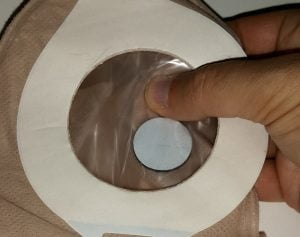
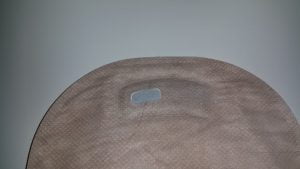
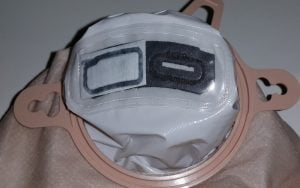
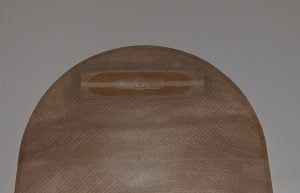
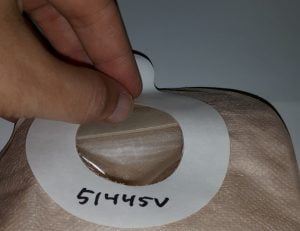

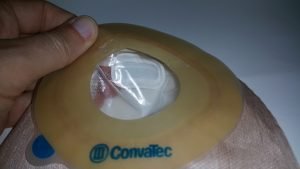
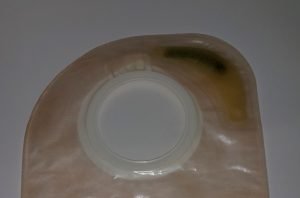

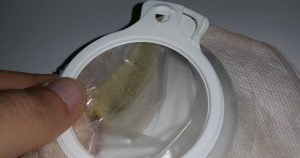
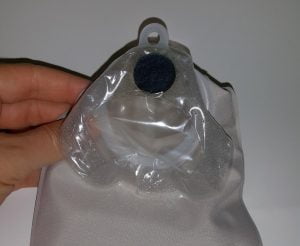
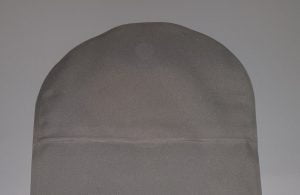






Tips for Using Pouches with Filters
- Some manufacturers require that you put a sticker over the filter before you get your appliance wet (i.e. during a shower or when swimming). This will prevent the filter from getting clogged from the outside, but it renders it ineffective until you remove that sticker.
- If you have liquid output, try to get it thicker by using a gelling agent or through dietary changes. I’ve got an entire article dedicated to dealing with liquid output HERE, and you might find that thicker stools will clog filters less.
- While liquid output can be a problem, so can thick output that sticks to the top of your pouch. When this happens, your filter gets covered (with poop) and can’t work well. Many ostomates will refer to this problem as “Pancaking”, and I have a full article that aims to tackle that problem HERE.
Pouch Vents
If your filter fails you and burping your pouch isn’t a practical option, you’ll be happy to know that there are special vents that can be attached to your pouch, which allow you to release gas from your bag.
The most popular of these products that I know of is the Osto EZ-Vent, which I’ve reviewed HERE.
While pouch vents are a great alternative, keep in mind that they still come with the same risks as burping your pouch: there’s still odor, and there’s still a chance for poop to blow out of the vent if you aren’t careful.
I’ve used vents extensively when I was a newish ostomate, and if used correctly, they work quite well.
“Burping” Your Ostomy Bag
Info: A dedicated article and video on how to burp your appliance can be found HERE.
Caution: Please use these instructions with caution. If you’ve never done this before, then be prepared to have a few accidents.
Commonly referred to as “burping”, some ostomates find they can release excess gas from their pouch without having to empty the bag completely.
This has a few advantages, but also comes with risk (it will smell), but despite those, I find burping my bag comes in really handy.
Burping a Drainable Pouch
To do this from your drainable pouch outlet, simply open the outlet and allow gas to escape.
If your pouch has some poop in it, it might help to lay down while doing this, so only gas comes out of that outlet.
This is not my preferred method of burping my pouch, but it can work if you’re in bed.
Burping a Two-Piece Pouch
If you don’t have a drainable pouch, or if you prefer to use a two-piece, you can also release gas from the flange coupling.
Note: this only works with mechanical coupling; don’t try to do this if you’re wearing an adhesive coupling system.
While standing, slowly open the top portion of your flange and allow air to escape. You can apply gentle pressure to your bag, but don’t squeeze too much, or you’ll get more than just gas coming out of there!
Once that’s done, simply snap the coupling back together.
With some practice, you should be able to do this without ever making a mess!
When I use this method, I try to do it before my pouch gets super-full of gas, as it minimizes the chance of things getting messy.
Regardless of what method you choose, make sure that you do it away from others, as the odor will likely be strong and offensive.
Low-FODMAP foods
The Low-FODMAP diet has been used to help people with IBD and IBS (these are not the same thing BTW) as it helps to eliminate foods that contain certain carbohydrates known to cause digestive upset in some people.
Foods That Are High in FODMAPs
- Apples
- Apricots
- Avocado
- Cashews
- Chickpeas
- Corn
- Lentils
- Mangoes
- Mushrooms
- Nectarines
- Pears
- Pistachios
- Wheat
That Are Low in FODMAPs
- Almonds (limited)
- Bananas
- Bell pepper
- Bok Choy
- Carrot
- Cucumber
- Grapes
- Oats
- Oranges
- Potatoes (white)
- rice
- Tofu
- Tomato
Here are a few resources for recipes and meal plans that focus on low FODMAP foods:
“Anti-Gas” Medication
There are certain over-the-counter drugs that can help to relieve gas.
As far as I know, these will not get rid of gas, but will simply allow gas to pass more easily and prevent pain or bloating associated with it.
Basically, they are anti-foaming agents, not anti-gas products. The most common ingredient found in these “anti-gas” drugs is Simethicone, and you can find it everything from Gas-X to Mylicon to special antacids and anti-diarrhea drugs.
I use to take Gas-X while in a Crohn’s flare and it did help with the pain, but I still had gas. I’ve never had to use it with my ostomy, but if bloating as gas pains happen to you, they might help.
I doubt that they’ll help with ballooning, as they don’t really cause gas to disappear.
Digestive Enzymes
If you find that certain foods or a combination of foods don’t digest well for you, you might want to consider taking dietary enzymes to help with those foods; they should help to break down what your body can’t/isn’t efficient enough to do on its own.
There are enzymes you can take that will break down specific compounds in foods, while others are enzyme complexes.
I never had luck with enzymes, but you might want to speak with your GI to see if it’s something you can try.
There are vegan enzymes, but not all are; be sure to check labels when you can or contact the manufacturer to confirm the ingredients.
One vegan alternative to the popular “Beano” product is Bean-Zyme. Deva makes a broad spectrum enzyme product too.
A word of caution: Many online stores and blogs that promote the use of digestive enzymes are really trying to hard-sell you these as miracle cures. They often make very misleading claims and don’t have much science to back them up. I would strongly encourage you to speak with your doctor or pharmacist about the use of digestive enzymes, especially if you have a digestive disease.
Products Containing Bismuth
Bismuth Subsalicylate is the stuff you’ll find in Pepto-Bismol, and it’s usually taken for diarrhea and heartburn relief, but it’s been found to reduce hydrogen sulfide, which is an offending gas in our gut (SOURCE).
Unfortunately, this stuff isn’t meant to be taken on an ongoing basis, and you really should talk to your GI if you consider taking it.
Another product, which has a slightly different version of bismuth (bismuth subgallate) and is safer to take, is Devrom. The tablet form is free of animal ingredients, and it should also help to reduce pouch odor as well.
These products claim to help reduce gas, and I’ve heard many success stories through ostomy forums when these products are used.
“What About These?”
I feel like I have to include this section, as there are many anecdotal remedies for gas relief.
While I’ve tried many myself (with no success), I will be posting what science has to say (if available) about these remedies. If you can tell me some that you’ve tried, I will add them to this list.
As with anything else you read, I always recommend checking with your doctor first before you decide to get into remedies, potions, magic and witchcraft.
Activated Charcoal
While activated charcoal does a great job at filtering things, eating it does nothing to reduce gas or odor – it will turn your output black, however.
This is one I tried before looking at the science.
The myth that it helps with gas is still being circulated around the internet. Simply put, this stuff doesn’t work (SOURCE, SOURCE).
Peppermint
Some people claim that peppermint, either taken as an oil or as a tea, will help to relieve gas. I haven’t found any studies which validate that claim.
Homeopathy Remedies
Shown to either be ineffective or simply as effective as placebo, homeopathic remedies aren’t worth even considering.
I fell for this one, and now use my experience with homeopathy to provide some comic relief, if nothing else.
Closing
Unfortunately, there isn’t a quick-fix to pouch ballooning. In a perfect world, we’d all be using working filters on our ostomy bags, but it doesn’t look like we’ll be living that dream anytime soon.
For now, we have a few options to control gas internally and also to help manage gas already in your pouch.
References
- Effect of processing on flatus-producing factors in legumes
- Bismuth subsalicylate markedly decreases hydrogen sulfide release in the human colon.
- Winham and Hutchins: Perceptions of flatulence from bean consumption among adults in 3 feeding studies. Nutrition Journal 2011 10:128
- Probiotics for the prevention and treatment of antibiotic-associated diarrhea: a systematic review and meta-analysis.
- Investigation of normal flatus production in healthy volunteers.
- A systematic review of systematic reviews of homeopathy.
- Activated charcoal: in vivo and in vitro studies of effect on gas formation.
- A systematic review of systematic reviews of homeopathy
Question: What tips can you share about managing pouch ballooning?





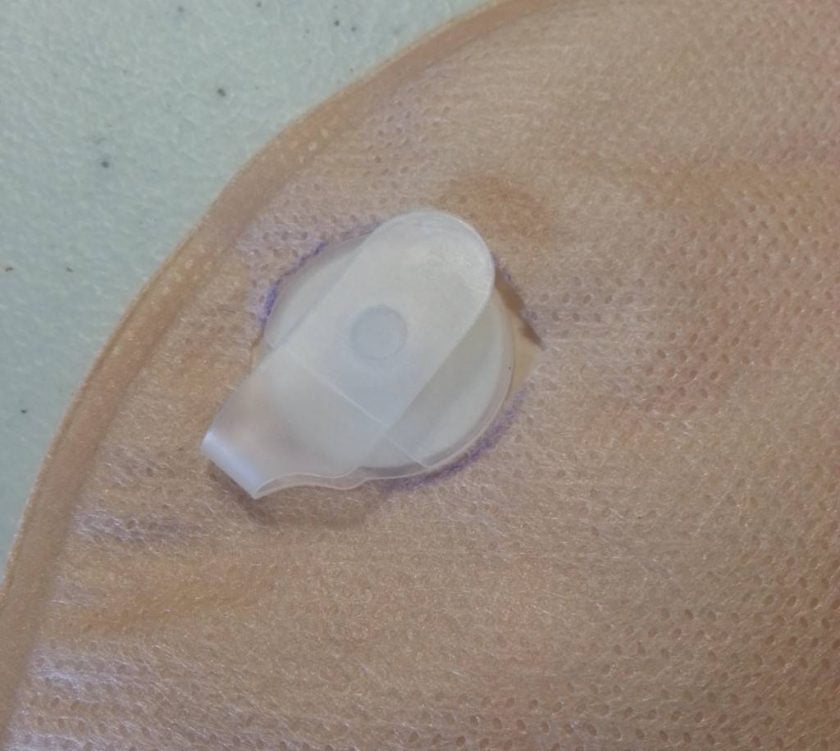







I think my insurance will cover them and my supplier has little to object to if they are cheaper than drainable bags. During the day, I don’t get (much) ballooning if I go easy on the garlic. I would use them for the night time only. To not need to get up at 3 am to change my appliance.
I did mistake ballooning for a really full bag this morning. I had undone the velcro to release gas, and it was a good thing I was standing over the toilet while I was doing it. There was no gas, only ouput. With the consistency of output I have, emptying is quite messy, I don’t know how you guys keep yourselves clean!
@cat-momma …Ballooning was my huge issue with my ileostomy as well. It became frustrating & embarassing in the day & robbed me of sleep something terrible at night.
I am on a very limited widows budget & decided to try the osto-e-z- vents. I grit my teeth paying out of pocket for them the first time, but now, they are a must for me to have!! Maybe order one pack if the delivery fee is worth it for you & give it a try. We install ourselves but those that use them here, have tips we can share to make it an easier process. The vents are much like the vents on beach balls.
I have a problem with ballooning too. Can’t burp my bag, because I use a one-piece system. I am now using drainable bags at night, so I can release the gas through the bottom of the bag, if necessary. This works well for me so far.
I don’t know if I’ll be allowed to order drainable bags every once in a while though. The ones I’m currently using were ordered by the hospital nurse, so I should be able to order them again. I’ll find out in a few weeks I guess.
I have an ileostomy. I don’t know how to wear the vertical stealth belt I purchased. Also, how can I tell if it’s leaking?
Hi Jojo,
I wear the vertical stealthbelt all the time. What are you having trouble with, specifically? When you put the belt on, there will be a hold on the back side (facing your stomach) that your ostomy bag goes through. The hold should fit around the base of your wafer, so it’s nice and secure.
As far as how to tell if it’s leaking, there are several ways. One, if the base of the wafer seems to be bulging, it’s likely that output found a way underneath. You may also notice smell, or even wetness coming through the wafer.
If the skin under my wafer becomes itchy, it’s likely that I have a small leak and need to replace the wafer.
When you remove your wafer, have a look at the back side and see if any stool spread from where the hole is. Over time, you’ll get an idea of what to expect.
I use the vitamin e illeostomy pouch it keeps ballooning all the time although it’s very comfy I am a new patent 3 weeks in after surgery what’s the answer it’s getting me down
Hi Dee,
I’m guessing that’s the Pelican pouch, right? I haven’t used that brand before, but one or more of the tips in this article should help you.
It may be worth investigating on why you have excess gas. Some gas is normal for everyone, but if your pouch is always ballooning, then it could be more diet related, or even medication you might be taking.
Even with bags that have filters, their ability to get rid of gas is very limited after the first 24h, so other measures must be taken.
Give us an update on what you’ve tried.